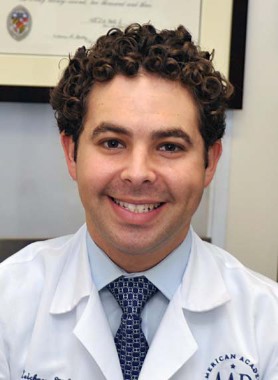User login
Limit Oral Acne Antibiotics to 3 Months
LAS VEGAS – Acne patients treated with oral antibiotics don’t necessarily need to stay on them for more than 3 months, according to Dr. Joshua Zeichner.
"Even if you are initially treating them with an oral antibiotic for severe acne, you can maintain them after about 12 weeks just on a topical therapy like tazarotene, explained Dr. Zeichner, director of cosmetic and clinical research in the dermatology department at Mt. Sinai Medical Center in New York. "You don’t necessarily need to keep your patients on oral antibiotics for long periods of time."
To prevent resistance and other problems, "try to limit use to about 3 months, and think about maintenance using just a topical therapy," he said at the Las Vegas Dermatology seminar, sponsored by the Skin Disease Education Foundation.
Several studies prove the point. In one, 189 patients with severe acne received 0.1% tazarotene gel each evening and 100 mg minocycline twice daily for 12 weeks. The 110 (58%) with at least a 75% global improvement were then assigned to 12 weeks of maintenance with tazarotene gel, minocycline, or tazarotene plus minocycline.
Keeping the antibiotic onboard past 12 weeks made no difference. All three groups – including the tazarotene-only group – did equally well. At week 24, more than 80% of the patients had at least a 50% global improvement from baseline, and 50% had at least a 75% improvement (Arch. Dermatol. 2006;142:605-12).
In his own practice, Dr. Zeichner said he often puts patients on oral antibiotics with topical therapies while they wait a month for their oral isotretinoin prescriptions to come through. "There are a lot of cases where patients don’t even end up going on isotretinoin because they are doing well," he said.
The approach also offers an alternative for severe acne patients who, for whatever reason, can’t take isotretinoin.
Another combination that’s been shown to work is minocycline extended release (Solodyn) about 1 mg/kg daily, daily clindamycin phosphate 1.2%/tretinoin 0.025% gel, and benzoil peroxide 6% foaming cloths. There’s an excellent chance isotretinoin candidates will no longer be candidates after 12 weeks of treatment, Dr. Zeichner said.
Some patients will need to stay on oral antibiotics a bit longer than 3 months. Even so, "try to get them off the antibiotic as early as possible. If they flare up again, [you can always] give them another course," he said.
Although the antibiotic may be stopped, Dr. Zeichner cautioned, it’s important to continue topical treatment to keep acne from coming back.
"I’d much rather see women on hormonal-type therapies than on oral antibiotics. I feel it gets a little more to the root of the issue," he noted.
Dr. Zeichner is a consultant, an investigator, or an advisory board member for several pharmaceutical companies, including Allergan, Beiersdorf, Galderma, Medicis, and Valeant. The SDEF and this publication are owned by Frontline Medical Communications.
LAS VEGAS – Acne patients treated with oral antibiotics don’t necessarily need to stay on them for more than 3 months, according to Dr. Joshua Zeichner.
"Even if you are initially treating them with an oral antibiotic for severe acne, you can maintain them after about 12 weeks just on a topical therapy like tazarotene, explained Dr. Zeichner, director of cosmetic and clinical research in the dermatology department at Mt. Sinai Medical Center in New York. "You don’t necessarily need to keep your patients on oral antibiotics for long periods of time."
To prevent resistance and other problems, "try to limit use to about 3 months, and think about maintenance using just a topical therapy," he said at the Las Vegas Dermatology seminar, sponsored by the Skin Disease Education Foundation.
Several studies prove the point. In one, 189 patients with severe acne received 0.1% tazarotene gel each evening and 100 mg minocycline twice daily for 12 weeks. The 110 (58%) with at least a 75% global improvement were then assigned to 12 weeks of maintenance with tazarotene gel, minocycline, or tazarotene plus minocycline.
Keeping the antibiotic onboard past 12 weeks made no difference. All three groups – including the tazarotene-only group – did equally well. At week 24, more than 80% of the patients had at least a 50% global improvement from baseline, and 50% had at least a 75% improvement (Arch. Dermatol. 2006;142:605-12).
In his own practice, Dr. Zeichner said he often puts patients on oral antibiotics with topical therapies while they wait a month for their oral isotretinoin prescriptions to come through. "There are a lot of cases where patients don’t even end up going on isotretinoin because they are doing well," he said.
The approach also offers an alternative for severe acne patients who, for whatever reason, can’t take isotretinoin.
Another combination that’s been shown to work is minocycline extended release (Solodyn) about 1 mg/kg daily, daily clindamycin phosphate 1.2%/tretinoin 0.025% gel, and benzoil peroxide 6% foaming cloths. There’s an excellent chance isotretinoin candidates will no longer be candidates after 12 weeks of treatment, Dr. Zeichner said.
Some patients will need to stay on oral antibiotics a bit longer than 3 months. Even so, "try to get them off the antibiotic as early as possible. If they flare up again, [you can always] give them another course," he said.
Although the antibiotic may be stopped, Dr. Zeichner cautioned, it’s important to continue topical treatment to keep acne from coming back.
"I’d much rather see women on hormonal-type therapies than on oral antibiotics. I feel it gets a little more to the root of the issue," he noted.
Dr. Zeichner is a consultant, an investigator, or an advisory board member for several pharmaceutical companies, including Allergan, Beiersdorf, Galderma, Medicis, and Valeant. The SDEF and this publication are owned by Frontline Medical Communications.
LAS VEGAS – Acne patients treated with oral antibiotics don’t necessarily need to stay on them for more than 3 months, according to Dr. Joshua Zeichner.
"Even if you are initially treating them with an oral antibiotic for severe acne, you can maintain them after about 12 weeks just on a topical therapy like tazarotene, explained Dr. Zeichner, director of cosmetic and clinical research in the dermatology department at Mt. Sinai Medical Center in New York. "You don’t necessarily need to keep your patients on oral antibiotics for long periods of time."
To prevent resistance and other problems, "try to limit use to about 3 months, and think about maintenance using just a topical therapy," he said at the Las Vegas Dermatology seminar, sponsored by the Skin Disease Education Foundation.
Several studies prove the point. In one, 189 patients with severe acne received 0.1% tazarotene gel each evening and 100 mg minocycline twice daily for 12 weeks. The 110 (58%) with at least a 75% global improvement were then assigned to 12 weeks of maintenance with tazarotene gel, minocycline, or tazarotene plus minocycline.
Keeping the antibiotic onboard past 12 weeks made no difference. All three groups – including the tazarotene-only group – did equally well. At week 24, more than 80% of the patients had at least a 50% global improvement from baseline, and 50% had at least a 75% improvement (Arch. Dermatol. 2006;142:605-12).
In his own practice, Dr. Zeichner said he often puts patients on oral antibiotics with topical therapies while they wait a month for their oral isotretinoin prescriptions to come through. "There are a lot of cases where patients don’t even end up going on isotretinoin because they are doing well," he said.
The approach also offers an alternative for severe acne patients who, for whatever reason, can’t take isotretinoin.
Another combination that’s been shown to work is minocycline extended release (Solodyn) about 1 mg/kg daily, daily clindamycin phosphate 1.2%/tretinoin 0.025% gel, and benzoil peroxide 6% foaming cloths. There’s an excellent chance isotretinoin candidates will no longer be candidates after 12 weeks of treatment, Dr. Zeichner said.
Some patients will need to stay on oral antibiotics a bit longer than 3 months. Even so, "try to get them off the antibiotic as early as possible. If they flare up again, [you can always] give them another course," he said.
Although the antibiotic may be stopped, Dr. Zeichner cautioned, it’s important to continue topical treatment to keep acne from coming back.
"I’d much rather see women on hormonal-type therapies than on oral antibiotics. I feel it gets a little more to the root of the issue," he noted.
Dr. Zeichner is a consultant, an investigator, or an advisory board member for several pharmaceutical companies, including Allergan, Beiersdorf, Galderma, Medicis, and Valeant. The SDEF and this publication are owned by Frontline Medical Communications.
EXPERT ANALYSIS FROM THE LAS VEGAS DERMATOLOGY SEMINAR
New Acne Treatment to Hit U.S. Market
A coming, branded formulation of isotretinoin will offer compliance and efficacy advantages not previously available to U.S. dermatologists.
Absorica is a novel, patented brand formulation of isotretinoin marketed in the United States by Ranbaxy Pharmaceuticals Inc. *It will be available by the end of 2012 for the treatment of severe recalcitrant nodular acne.
The new drug, approved by the Food and Drug Administration in May, isn’t just another therapeutic option for dermatologists looking to treat acne – it’s a potential game changer in terms of improving efficacy and preventing relapse, according to Dr. Eric "Billy" Baum of the University of Alabama, Birmingham, who is a member of the speakers’ bureau for Ranbaxy.
Absorica is not rated as A-B equivalent to Accutane and the other isotretinoins, Dr. Baum said.
"I think that this is going to be a great advantage to dermatologists today," he said in an interview. "They’ll be able to have a type of isotretinoin that they know they are going to see really good results with. They are going to get the high blood levels that they need in order to get the maximum improvement, maximum absorption, and maximum efficacy."
Absorption is the key difference between how Absorica works and how other isotretinoins work, Dr. Baum explained at the meeting sponsored by Skin Disease Education Foundation.
Isotretinoin is highly lipophilic and is a poorly solubilized molecule. As a result, patients don’t get the maximum benefit of the drug unless they take it with a high-fat meal, ideally about 50 grams of fat, according to Dr. Baum. That’s the equivalent of a breakfast of two fried eggs in butter, two strips of bacon, two slices of toast with butter, 4 ounces of hash brown potatoes, and 8 ounces of whole milk, he said. Since isotretinoin is taken twice daily, patients should also eat another high-fat meal at dinnertime, he said.
But most adolescent patients taking isotretinoin don’t eat that type of high-fat diet – in fact, about a third of adolescents don’t eat breakfast at all, he said.
With the traditional form of isotretinoin, only about 40% of the drug was absorbed when patients were fasting. In contrast, with Absorica nearly 70% is absorbed, Dr. Baum said. "There is now a greater likelihood for patients to achieve cumulative targeted doses of isotretinoin in the 20 weeks of treatment, thereby increasing success of treatment and lowering the risk of relapse."
The better absorption with Absorica is due to a patented drug delivery system, which delivers isotretinoin along with fatty molecules, optimizing absorption in the small intestine, Dr. Baum explained.
A phase III trial with more than 900 patients showed no statistical difference in efficacy at 20 weeks between Absorica and Accutane when patients have eaten a high-fat meal. "You get the results that were achieved with the original Accutane under fed conditions with less concern about what patients will actually eat," Dr. Baum said.
There was also no notable difference in psychiatric, gastrointestinal, vascular, cardiac, or ophthalmic side effects between the two formulations, Dr. Baum said, adding that like all isotretinoins, Absorica patients and prescribers are obligated to participate in the iPLEDGE risk management program.
"This is a medication that’s been very highly studied, the largest clinical study on isotretinoin ever completed," he said.
The better rate of absorption is this formulation’s big clinical advantage, which should result in fewer relapses, Dr. Baum said. That could also make the drug more cost effective, because it would cut down on subsequent treatments in the event of relapse.
"It is important to treat isotretinoin patients most effectively in one cycle, if possible," Dr. Baum said. "This is the time where the patient is most motivated and has the most family support to comply with the complicated instructions of isotretinoin and iPLEDGE."
SDEF and this news organization are owned by Frontline Medical Communications.
*CORRECTION (11/07/12): A previous version of this story incorrectly reported when Absorica will be available in the U.S. This version has been updated.
A coming, branded formulation of isotretinoin will offer compliance and efficacy advantages not previously available to U.S. dermatologists.
Absorica is a novel, patented brand formulation of isotretinoin marketed in the United States by Ranbaxy Pharmaceuticals Inc. *It will be available by the end of 2012 for the treatment of severe recalcitrant nodular acne.
The new drug, approved by the Food and Drug Administration in May, isn’t just another therapeutic option for dermatologists looking to treat acne – it’s a potential game changer in terms of improving efficacy and preventing relapse, according to Dr. Eric "Billy" Baum of the University of Alabama, Birmingham, who is a member of the speakers’ bureau for Ranbaxy.
Absorica is not rated as A-B equivalent to Accutane and the other isotretinoins, Dr. Baum said.
"I think that this is going to be a great advantage to dermatologists today," he said in an interview. "They’ll be able to have a type of isotretinoin that they know they are going to see really good results with. They are going to get the high blood levels that they need in order to get the maximum improvement, maximum absorption, and maximum efficacy."
Absorption is the key difference between how Absorica works and how other isotretinoins work, Dr. Baum explained at the meeting sponsored by Skin Disease Education Foundation.
Isotretinoin is highly lipophilic and is a poorly solubilized molecule. As a result, patients don’t get the maximum benefit of the drug unless they take it with a high-fat meal, ideally about 50 grams of fat, according to Dr. Baum. That’s the equivalent of a breakfast of two fried eggs in butter, two strips of bacon, two slices of toast with butter, 4 ounces of hash brown potatoes, and 8 ounces of whole milk, he said. Since isotretinoin is taken twice daily, patients should also eat another high-fat meal at dinnertime, he said.
But most adolescent patients taking isotretinoin don’t eat that type of high-fat diet – in fact, about a third of adolescents don’t eat breakfast at all, he said.
With the traditional form of isotretinoin, only about 40% of the drug was absorbed when patients were fasting. In contrast, with Absorica nearly 70% is absorbed, Dr. Baum said. "There is now a greater likelihood for patients to achieve cumulative targeted doses of isotretinoin in the 20 weeks of treatment, thereby increasing success of treatment and lowering the risk of relapse."
The better absorption with Absorica is due to a patented drug delivery system, which delivers isotretinoin along with fatty molecules, optimizing absorption in the small intestine, Dr. Baum explained.
A phase III trial with more than 900 patients showed no statistical difference in efficacy at 20 weeks between Absorica and Accutane when patients have eaten a high-fat meal. "You get the results that were achieved with the original Accutane under fed conditions with less concern about what patients will actually eat," Dr. Baum said.
There was also no notable difference in psychiatric, gastrointestinal, vascular, cardiac, or ophthalmic side effects between the two formulations, Dr. Baum said, adding that like all isotretinoins, Absorica patients and prescribers are obligated to participate in the iPLEDGE risk management program.
"This is a medication that’s been very highly studied, the largest clinical study on isotretinoin ever completed," he said.
The better rate of absorption is this formulation’s big clinical advantage, which should result in fewer relapses, Dr. Baum said. That could also make the drug more cost effective, because it would cut down on subsequent treatments in the event of relapse.
"It is important to treat isotretinoin patients most effectively in one cycle, if possible," Dr. Baum said. "This is the time where the patient is most motivated and has the most family support to comply with the complicated instructions of isotretinoin and iPLEDGE."
SDEF and this news organization are owned by Frontline Medical Communications.
*CORRECTION (11/07/12): A previous version of this story incorrectly reported when Absorica will be available in the U.S. This version has been updated.
A coming, branded formulation of isotretinoin will offer compliance and efficacy advantages not previously available to U.S. dermatologists.
Absorica is a novel, patented brand formulation of isotretinoin marketed in the United States by Ranbaxy Pharmaceuticals Inc. *It will be available by the end of 2012 for the treatment of severe recalcitrant nodular acne.
The new drug, approved by the Food and Drug Administration in May, isn’t just another therapeutic option for dermatologists looking to treat acne – it’s a potential game changer in terms of improving efficacy and preventing relapse, according to Dr. Eric "Billy" Baum of the University of Alabama, Birmingham, who is a member of the speakers’ bureau for Ranbaxy.
Absorica is not rated as A-B equivalent to Accutane and the other isotretinoins, Dr. Baum said.
"I think that this is going to be a great advantage to dermatologists today," he said in an interview. "They’ll be able to have a type of isotretinoin that they know they are going to see really good results with. They are going to get the high blood levels that they need in order to get the maximum improvement, maximum absorption, and maximum efficacy."
Absorption is the key difference between how Absorica works and how other isotretinoins work, Dr. Baum explained at the meeting sponsored by Skin Disease Education Foundation.
Isotretinoin is highly lipophilic and is a poorly solubilized molecule. As a result, patients don’t get the maximum benefit of the drug unless they take it with a high-fat meal, ideally about 50 grams of fat, according to Dr. Baum. That’s the equivalent of a breakfast of two fried eggs in butter, two strips of bacon, two slices of toast with butter, 4 ounces of hash brown potatoes, and 8 ounces of whole milk, he said. Since isotretinoin is taken twice daily, patients should also eat another high-fat meal at dinnertime, he said.
But most adolescent patients taking isotretinoin don’t eat that type of high-fat diet – in fact, about a third of adolescents don’t eat breakfast at all, he said.
With the traditional form of isotretinoin, only about 40% of the drug was absorbed when patients were fasting. In contrast, with Absorica nearly 70% is absorbed, Dr. Baum said. "There is now a greater likelihood for patients to achieve cumulative targeted doses of isotretinoin in the 20 weeks of treatment, thereby increasing success of treatment and lowering the risk of relapse."
The better absorption with Absorica is due to a patented drug delivery system, which delivers isotretinoin along with fatty molecules, optimizing absorption in the small intestine, Dr. Baum explained.
A phase III trial with more than 900 patients showed no statistical difference in efficacy at 20 weeks between Absorica and Accutane when patients have eaten a high-fat meal. "You get the results that were achieved with the original Accutane under fed conditions with less concern about what patients will actually eat," Dr. Baum said.
There was also no notable difference in psychiatric, gastrointestinal, vascular, cardiac, or ophthalmic side effects between the two formulations, Dr. Baum said, adding that like all isotretinoins, Absorica patients and prescribers are obligated to participate in the iPLEDGE risk management program.
"This is a medication that’s been very highly studied, the largest clinical study on isotretinoin ever completed," he said.
The better rate of absorption is this formulation’s big clinical advantage, which should result in fewer relapses, Dr. Baum said. That could also make the drug more cost effective, because it would cut down on subsequent treatments in the event of relapse.
"It is important to treat isotretinoin patients most effectively in one cycle, if possible," Dr. Baum said. "This is the time where the patient is most motivated and has the most family support to comply with the complicated instructions of isotretinoin and iPLEDGE."
SDEF and this news organization are owned by Frontline Medical Communications.
*CORRECTION (11/07/12): A previous version of this story incorrectly reported when Absorica will be available in the U.S. This version has been updated.
EXPERT ANALYSIS FROM THE SDEF LAS VEGAS DERMATOLOGY SEMINAR
Phototoxic and Photoallergic Potential of Tazarotene Foam 0.1% in 2 Phase 1 Patch Studies
A Dermatologist's Dilemma: Treatment Failure or Failure to Treat? [editorial]
Low-Dose Isotretinoin Tames Adult Acne
PRAGUE – Oral isotretinoin dosed at 5 mg per day proved to be highly effective, fast acting, and well tolerated for persistent, low-grade, adult acne in a randomized, double-blind clinical trial.
Results of this study provide physicians with evidence supporting the use of low-dose isotretinoin in the management of adult acne, Dr. Marius Rademaker said at the annual congress of the European Academy of Dermatology and Venereology.
"There’s a high degree of dissatisfaction with treatment among adult acne sufferers because of their usual slow response to the traditional acne therapies, the poor clearance, and the very high relapse rate when you stop treatment. The standards of a woman of 35 with adult acne are quite different from those of a 15-year-old. I think people no longer want 70% improvement, they want 100% clearance," said Dr. Rademaker, a dermatologist at Waikato Hospital in Hamilton, New Zealand.
There have been few randomized, controlled studies focusing on treatment of adult acne, he reported, adding that he could find no studies involving systemic antibiotics for acne in adults. He found a few studies on topical retinoid trials, but they only included a minority of adults. And, he found no studies assessing the effectiveness of low dose isotretinoin for adults.
Therefore, he conducted a randomized trial of isotretinoin at 5 mg/day to determine if a lower dose would be as effective and would have fewer adverse events than the standard dose of 0.5-1.0 mg/kg per day. Avoiding relapse upon discontinuation of isotretinoin appears to be more a function of the duration of sebaceous gland suppression – longer is better – than of cumulative dose, he added.
He reported on 58 adults aged 25-55 with low-grade, indolent acne that had persisted since adolescence. Nearly 90% were women. Participants were randomized double-blind to 16 weeks of isotretinoin 5 mg/day or placebo, followed by an additional 16 weeks of open-label isotretinoin in both study arms. The primary end point was the change in the number of facial acne lesions between baseline and week 16.
The acne lesion count in the isotretinoin group was reduced by half within the first 4 weeks of the study, from a mean baseline of 10.6 lesions. By week 16, the group’s mean acne lesion count had dropped to 3.2. After a further 16 weeks of open-label therapy, it had fallen to 1.3.
In contrast, the mean acne lesion count in the control group didn’t change significantly over the first 16 weeks from a baseline of 9.7 lesions. After a subsequent 16 weeks of open-label isotretinoin, acne count dropped to 3.9.
A secondary outcome measure was change in Dermatology Life Quality Index (DLQI) scores. From a mean baseline score of 4.8, indicative of moderate skin disease–related disability, the score fell to 1.3 after 16 weeks of double-blind isotretinoin and to 1.2 after another 16 weeks of open-label therapy. The mean DLQI score of 4.9 was unchanged in the control group after 16 weeks of placebo, but dropped to 2.3 after 16 weeks of open-label isotretinoin.
In an interview, Dr. Neil S. Goldberg, a dermatologist in Bronxville, N.Y, questioned the blindness of any study involving isotretinoin. "No isotretinoin study can be blinded. The side effects of isotretinoin, even low dose, are just too obvious."
The most common side effect in the study was dry lips, which nearly two-thirds of patients reported while on isotretinoin. Dry skin, musculoskeletal aches and pains, dry eyes, and fatigue were less frequently reported. One patient withdrew from the study because of anxiety and mood changes that may or may not have been treatment related, Dr. Rademaker said.
He added that in his experience, after a year of treatment at 5 mg/day, virtually all patients with persistent low-grade adult acne no longer have any acne. He is pursing the possibilities of conducting a long-term, follow-up study.
"Isotretinoin seems to me to be just as valuable a treatment in adults as in teenagers," said Dr. Steven R. Feldman, professor of dermatology at Wake Forest Baptist Medical Center in Winston-Salem, N.C. "My standard approach is to use it in the same way, though using it in lower doses for longer periods of time is reasonable and often effective with fewer side effects." Caution is warranted, however, when prescribing isotretinoin to women of childbearing potential because of the drug’s known teratogenicity.
In response to audience questions about restrictions placed upon isotretinoin prescribing in New Zealand, Dr. Rademaker replied that his country’s pregnancy prevention plan requires patient education but not mandatory pregnancy tests. "And our pregnancy rates [for females on isotretinoin] are lower than in Europe or the U.S.," he said.
"iPledge makes everything harder. It inhibits flexibility. In Australia – where my two nieces and nephew live – when they started isotretinoin, the doctor just gave them 6 months of isotretinoin and sent them on their way," said Dr. Goldberg.
Clinical acne is present in 45% of women aged 21-30 years, 26% of women aged 31-40, and 12% of women aged 41-50, according to the results of a recent cross-sectional study of 2,895 U.S. females aged 10-70 years (J. Womens Health [Larchmt] 2012;21:223-30).
Dr. Rademaker’s investigator-initiated study was sponsored by Douglas Pharmaceuticals (an isotretinoin manufacturer in New Zealand). He had no other conflicts of interest. Dr. Feldman reported significant financial relationships with several pharmaceutical companies. Dr. Goldberg had no financial conflicts to report.
In the United States, 5 mg of isotretinoin is not available, so dermatologists usually prescribe 10 mg per day as a low dose, according to Dr. Hilary E. Baldwin. She noted that she prescribes low-dose isotretinoin for adults, but not for getting patients from 70% to 100% clear.
 |
|
She added that she often prescribes isotretinoin for women who tend to get one to two large acne lesions per week. "Topical products are ineffective on this type of lesion and it is hard to justify long-term use of antibiotics for 1-2 lesions per week. Antibiotic resistance is of crucial importance in these patients. Alternatives to long term/low dose isotretinoin include oral contraceptives and spironolactone. However, some adult patients exceed the safe-age contraindications for OCPs," she said.
Dr. Baldwin is vice chair of dermatology at the State University of New York, Brooklyn. She has received research funds from and/or serves as a consultant to Allergan, Coria, Galderma, GlaxoSmithKline, Graceway Pharmaceuticals, L’Oreal, Ortho Dermatologics, Medicis, and Sanofi-Aventis.
In the United States, 5 mg of isotretinoin is not available, so dermatologists usually prescribe 10 mg per day as a low dose, according to Dr. Hilary E. Baldwin. She noted that she prescribes low-dose isotretinoin for adults, but not for getting patients from 70% to 100% clear.
 |
|
She added that she often prescribes isotretinoin for women who tend to get one to two large acne lesions per week. "Topical products are ineffective on this type of lesion and it is hard to justify long-term use of antibiotics for 1-2 lesions per week. Antibiotic resistance is of crucial importance in these patients. Alternatives to long term/low dose isotretinoin include oral contraceptives and spironolactone. However, some adult patients exceed the safe-age contraindications for OCPs," she said.
Dr. Baldwin is vice chair of dermatology at the State University of New York, Brooklyn. She has received research funds from and/or serves as a consultant to Allergan, Coria, Galderma, GlaxoSmithKline, Graceway Pharmaceuticals, L’Oreal, Ortho Dermatologics, Medicis, and Sanofi-Aventis.
In the United States, 5 mg of isotretinoin is not available, so dermatologists usually prescribe 10 mg per day as a low dose, according to Dr. Hilary E. Baldwin. She noted that she prescribes low-dose isotretinoin for adults, but not for getting patients from 70% to 100% clear.
 |
|
She added that she often prescribes isotretinoin for women who tend to get one to two large acne lesions per week. "Topical products are ineffective on this type of lesion and it is hard to justify long-term use of antibiotics for 1-2 lesions per week. Antibiotic resistance is of crucial importance in these patients. Alternatives to long term/low dose isotretinoin include oral contraceptives and spironolactone. However, some adult patients exceed the safe-age contraindications for OCPs," she said.
Dr. Baldwin is vice chair of dermatology at the State University of New York, Brooklyn. She has received research funds from and/or serves as a consultant to Allergan, Coria, Galderma, GlaxoSmithKline, Graceway Pharmaceuticals, L’Oreal, Ortho Dermatologics, Medicis, and Sanofi-Aventis.
PRAGUE – Oral isotretinoin dosed at 5 mg per day proved to be highly effective, fast acting, and well tolerated for persistent, low-grade, adult acne in a randomized, double-blind clinical trial.
Results of this study provide physicians with evidence supporting the use of low-dose isotretinoin in the management of adult acne, Dr. Marius Rademaker said at the annual congress of the European Academy of Dermatology and Venereology.
"There’s a high degree of dissatisfaction with treatment among adult acne sufferers because of their usual slow response to the traditional acne therapies, the poor clearance, and the very high relapse rate when you stop treatment. The standards of a woman of 35 with adult acne are quite different from those of a 15-year-old. I think people no longer want 70% improvement, they want 100% clearance," said Dr. Rademaker, a dermatologist at Waikato Hospital in Hamilton, New Zealand.
There have been few randomized, controlled studies focusing on treatment of adult acne, he reported, adding that he could find no studies involving systemic antibiotics for acne in adults. He found a few studies on topical retinoid trials, but they only included a minority of adults. And, he found no studies assessing the effectiveness of low dose isotretinoin for adults.
Therefore, he conducted a randomized trial of isotretinoin at 5 mg/day to determine if a lower dose would be as effective and would have fewer adverse events than the standard dose of 0.5-1.0 mg/kg per day. Avoiding relapse upon discontinuation of isotretinoin appears to be more a function of the duration of sebaceous gland suppression – longer is better – than of cumulative dose, he added.
He reported on 58 adults aged 25-55 with low-grade, indolent acne that had persisted since adolescence. Nearly 90% were women. Participants were randomized double-blind to 16 weeks of isotretinoin 5 mg/day or placebo, followed by an additional 16 weeks of open-label isotretinoin in both study arms. The primary end point was the change in the number of facial acne lesions between baseline and week 16.
The acne lesion count in the isotretinoin group was reduced by half within the first 4 weeks of the study, from a mean baseline of 10.6 lesions. By week 16, the group’s mean acne lesion count had dropped to 3.2. After a further 16 weeks of open-label therapy, it had fallen to 1.3.
In contrast, the mean acne lesion count in the control group didn’t change significantly over the first 16 weeks from a baseline of 9.7 lesions. After a subsequent 16 weeks of open-label isotretinoin, acne count dropped to 3.9.
A secondary outcome measure was change in Dermatology Life Quality Index (DLQI) scores. From a mean baseline score of 4.8, indicative of moderate skin disease–related disability, the score fell to 1.3 after 16 weeks of double-blind isotretinoin and to 1.2 after another 16 weeks of open-label therapy. The mean DLQI score of 4.9 was unchanged in the control group after 16 weeks of placebo, but dropped to 2.3 after 16 weeks of open-label isotretinoin.
In an interview, Dr. Neil S. Goldberg, a dermatologist in Bronxville, N.Y, questioned the blindness of any study involving isotretinoin. "No isotretinoin study can be blinded. The side effects of isotretinoin, even low dose, are just too obvious."
The most common side effect in the study was dry lips, which nearly two-thirds of patients reported while on isotretinoin. Dry skin, musculoskeletal aches and pains, dry eyes, and fatigue were less frequently reported. One patient withdrew from the study because of anxiety and mood changes that may or may not have been treatment related, Dr. Rademaker said.
He added that in his experience, after a year of treatment at 5 mg/day, virtually all patients with persistent low-grade adult acne no longer have any acne. He is pursing the possibilities of conducting a long-term, follow-up study.
"Isotretinoin seems to me to be just as valuable a treatment in adults as in teenagers," said Dr. Steven R. Feldman, professor of dermatology at Wake Forest Baptist Medical Center in Winston-Salem, N.C. "My standard approach is to use it in the same way, though using it in lower doses for longer periods of time is reasonable and often effective with fewer side effects." Caution is warranted, however, when prescribing isotretinoin to women of childbearing potential because of the drug’s known teratogenicity.
In response to audience questions about restrictions placed upon isotretinoin prescribing in New Zealand, Dr. Rademaker replied that his country’s pregnancy prevention plan requires patient education but not mandatory pregnancy tests. "And our pregnancy rates [for females on isotretinoin] are lower than in Europe or the U.S.," he said.
"iPledge makes everything harder. It inhibits flexibility. In Australia – where my two nieces and nephew live – when they started isotretinoin, the doctor just gave them 6 months of isotretinoin and sent them on their way," said Dr. Goldberg.
Clinical acne is present in 45% of women aged 21-30 years, 26% of women aged 31-40, and 12% of women aged 41-50, according to the results of a recent cross-sectional study of 2,895 U.S. females aged 10-70 years (J. Womens Health [Larchmt] 2012;21:223-30).
Dr. Rademaker’s investigator-initiated study was sponsored by Douglas Pharmaceuticals (an isotretinoin manufacturer in New Zealand). He had no other conflicts of interest. Dr. Feldman reported significant financial relationships with several pharmaceutical companies. Dr. Goldberg had no financial conflicts to report.
PRAGUE – Oral isotretinoin dosed at 5 mg per day proved to be highly effective, fast acting, and well tolerated for persistent, low-grade, adult acne in a randomized, double-blind clinical trial.
Results of this study provide physicians with evidence supporting the use of low-dose isotretinoin in the management of adult acne, Dr. Marius Rademaker said at the annual congress of the European Academy of Dermatology and Venereology.
"There’s a high degree of dissatisfaction with treatment among adult acne sufferers because of their usual slow response to the traditional acne therapies, the poor clearance, and the very high relapse rate when you stop treatment. The standards of a woman of 35 with adult acne are quite different from those of a 15-year-old. I think people no longer want 70% improvement, they want 100% clearance," said Dr. Rademaker, a dermatologist at Waikato Hospital in Hamilton, New Zealand.
There have been few randomized, controlled studies focusing on treatment of adult acne, he reported, adding that he could find no studies involving systemic antibiotics for acne in adults. He found a few studies on topical retinoid trials, but they only included a minority of adults. And, he found no studies assessing the effectiveness of low dose isotretinoin for adults.
Therefore, he conducted a randomized trial of isotretinoin at 5 mg/day to determine if a lower dose would be as effective and would have fewer adverse events than the standard dose of 0.5-1.0 mg/kg per day. Avoiding relapse upon discontinuation of isotretinoin appears to be more a function of the duration of sebaceous gland suppression – longer is better – than of cumulative dose, he added.
He reported on 58 adults aged 25-55 with low-grade, indolent acne that had persisted since adolescence. Nearly 90% were women. Participants were randomized double-blind to 16 weeks of isotretinoin 5 mg/day or placebo, followed by an additional 16 weeks of open-label isotretinoin in both study arms. The primary end point was the change in the number of facial acne lesions between baseline and week 16.
The acne lesion count in the isotretinoin group was reduced by half within the first 4 weeks of the study, from a mean baseline of 10.6 lesions. By week 16, the group’s mean acne lesion count had dropped to 3.2. After a further 16 weeks of open-label therapy, it had fallen to 1.3.
In contrast, the mean acne lesion count in the control group didn’t change significantly over the first 16 weeks from a baseline of 9.7 lesions. After a subsequent 16 weeks of open-label isotretinoin, acne count dropped to 3.9.
A secondary outcome measure was change in Dermatology Life Quality Index (DLQI) scores. From a mean baseline score of 4.8, indicative of moderate skin disease–related disability, the score fell to 1.3 after 16 weeks of double-blind isotretinoin and to 1.2 after another 16 weeks of open-label therapy. The mean DLQI score of 4.9 was unchanged in the control group after 16 weeks of placebo, but dropped to 2.3 after 16 weeks of open-label isotretinoin.
In an interview, Dr. Neil S. Goldberg, a dermatologist in Bronxville, N.Y, questioned the blindness of any study involving isotretinoin. "No isotretinoin study can be blinded. The side effects of isotretinoin, even low dose, are just too obvious."
The most common side effect in the study was dry lips, which nearly two-thirds of patients reported while on isotretinoin. Dry skin, musculoskeletal aches and pains, dry eyes, and fatigue were less frequently reported. One patient withdrew from the study because of anxiety and mood changes that may or may not have been treatment related, Dr. Rademaker said.
He added that in his experience, after a year of treatment at 5 mg/day, virtually all patients with persistent low-grade adult acne no longer have any acne. He is pursing the possibilities of conducting a long-term, follow-up study.
"Isotretinoin seems to me to be just as valuable a treatment in adults as in teenagers," said Dr. Steven R. Feldman, professor of dermatology at Wake Forest Baptist Medical Center in Winston-Salem, N.C. "My standard approach is to use it in the same way, though using it in lower doses for longer periods of time is reasonable and often effective with fewer side effects." Caution is warranted, however, when prescribing isotretinoin to women of childbearing potential because of the drug’s known teratogenicity.
In response to audience questions about restrictions placed upon isotretinoin prescribing in New Zealand, Dr. Rademaker replied that his country’s pregnancy prevention plan requires patient education but not mandatory pregnancy tests. "And our pregnancy rates [for females on isotretinoin] are lower than in Europe or the U.S.," he said.
"iPledge makes everything harder. It inhibits flexibility. In Australia – where my two nieces and nephew live – when they started isotretinoin, the doctor just gave them 6 months of isotretinoin and sent them on their way," said Dr. Goldberg.
Clinical acne is present in 45% of women aged 21-30 years, 26% of women aged 31-40, and 12% of women aged 41-50, according to the results of a recent cross-sectional study of 2,895 U.S. females aged 10-70 years (J. Womens Health [Larchmt] 2012;21:223-30).
Dr. Rademaker’s investigator-initiated study was sponsored by Douglas Pharmaceuticals (an isotretinoin manufacturer in New Zealand). He had no other conflicts of interest. Dr. Feldman reported significant financial relationships with several pharmaceutical companies. Dr. Goldberg had no financial conflicts to report.
AT THE ANNUAL CONGRESS OF THE EUROPEAN ACADEMY OF DERMATOLOGY AND VENEREOLOGY
Major Finding: Sixteen weeks of low-dose isotretinoin at 5 mg/day in patients with persistent, low-grade adult acne resulted in a reduction in mean facial lesion count from 10.6 at baseline to 3.2, with a further 16 weeks of open-label isotretinoin dropping the lesion count to 1.3.
Data Source: This was a randomized, double-blind, placebo-controlled trial involving 58 adults aged 25-55 with persistent, low-grade acne since adolescence.
Disclosures: Dr. Rademaker’s investigator-initiated study was sponsored by Douglas Pharmaceuticals (an isotretinoin manufacturer in New Zealand). He had no other conflicts of interest.
Acne and Whey Protein Supplementation
Cumulative Irritation Potential and Contact Sensitization Potential of Tazarotene Foam 0.1% in 2 Phase 1 Patch Studies
Adult Acne Woes: The Skinny Podcast
In this month's program, Dermatologist Toby Maurer, who founded the HIV dermatology clinic at San Francisco General Hospital, talks about the toll Kaposi's sarcoma is taking on HIV patients.
We review the role of online dermatology videos in the education of medical students.
Then, reporter Mary Ellen Schneider highlights the top read stories on www.skinandallergynews.com, and Dr. Lily Talakoub talks about a condition that continues to plague adult patients - acne.
Lastly, Dr. Alan Rockoff relays a tale about children and warts.
In this month's program, Dermatologist Toby Maurer, who founded the HIV dermatology clinic at San Francisco General Hospital, talks about the toll Kaposi's sarcoma is taking on HIV patients.
We review the role of online dermatology videos in the education of medical students.
Then, reporter Mary Ellen Schneider highlights the top read stories on www.skinandallergynews.com, and Dr. Lily Talakoub talks about a condition that continues to plague adult patients - acne.
Lastly, Dr. Alan Rockoff relays a tale about children and warts.
In this month's program, Dermatologist Toby Maurer, who founded the HIV dermatology clinic at San Francisco General Hospital, talks about the toll Kaposi's sarcoma is taking on HIV patients.
We review the role of online dermatology videos in the education of medical students.
Then, reporter Mary Ellen Schneider highlights the top read stories on www.skinandallergynews.com, and Dr. Lily Talakoub talks about a condition that continues to plague adult patients - acne.
Lastly, Dr. Alan Rockoff relays a tale about children and warts.
Acne Prescriptions for Topical Combination Therapy Rising
BOSTON – Although there are proven clinical advantages to prescribing topical combination therapies for acne, the benefits must be weighed against the higher cost and loss of flexibility of the products, according to Dr. Laura F. Sandoval.
The use of "combination products allows physicians to adhere to current acne treatment guidelines," which can be complex, as they direct the use of multiple agents for optimal treatment, noted Dr. Sandoval and her colleagues. Combination products with benzoyl peroxide (BPO), however, help decrease the incidence of antibiotic resistance, which is a growing concern in the treatment of acne.
On the heels of a recent meta-analysis of studies comparing combination topical therapy to retinoid monotherapy for acne vulgaris, in which combination treatment was more effective than monotherapy in eight of the nine studies evaluated (J. Drugs Dermatol. 2011;10:636-44), Dr. Sandoval and her colleagues at the Center for Dermatology Research at Wake Forest University, Winston-Salem, N.C., sought to assess practice trends regarding the use of topical combination products in specialty and general practices.
The investigators used the National Ambulatory Medical Care Survey (NAMCS) database to identify acne visits from 1989 to 2009 and to compare prescribing practices between dermatologists and primary care physicians.
From 1989 to 2009, dermatologists and primary care physicians prescribed combination products to 11.5% and 12.6% of their acne patients, respectively, representing frequency increases during the same time period of 0.66% and 1.26%, Dr. Sandoval and her colleagues reported at the American Academy of Dermatology’s Summer Academy Meeting.
From 2007 to 2009, the respective prescription rates of combination products were 20% (dermatology) and 33.8% (primary care). The findings may be a reflection of clinicians’ desire to streamline patient management and improve treatment adherence – both of which can be compromised by the complexity of juggling topical drugs from multiple classes, Dr. Sandoval said in an interview.
During the 20-year period, topical retinoids were the most common treatment for acne and tretinoin was the top retinoid, accounting for 19.2% of prescriptions for acne from dermatologists and 17.9% from primary care physicians, Dr. Sandoval reported in a poster at the meeting. Two combination products – clindamycin/BPO and erythromycin/BPO – were among the top 10 products used by both dermatologists (4.7% and 6.3% of prescriptions, respectively) and primary care physicians (3.4% and 7.9%, respectively).
From 2007 to 2009, dermatologists prescribed clindamycin/BPO for 16.4% of acne visits and clindamycin/tretinoin for 3.9%, while primary care physicians prescribed clindamycin/BPO for 15.6% of acne visits, erythromycin/BPO for 14.6% of acne visits, and the oral contraceptive combination norgestimate/ethinyl estradiol for 8.6%, according to the analysis.
The Center for Dermatology Research at Wake Forest is supported by an educational grant from Galderma. The principal investigator, Dr. Steven R. Feldman, reported significant financial relationships with several pharmaceutical companies, including Galderma. Dr. Sandoval and her other coauthors reported no conflicts of interest.
). The findings may be a reflection of clinicians’ desire to streamline patient management and improve treatment adherence – both of which can be compromised by the complexity of juggling topical drugs from multiple classes, Dr. Sandoval said in an interview.
During the 20-year period, topical retinoids were the most common treatment for acne and tretinoin was the top retinoid, accounting for 19.2% of prescriptions for acne from dermatologists and 17.9% from primary care physicians, Dr. Sandoval reported in a poster at the meeting. Two combination products – clindamycin/BPO and erythromycin/BPO – were among the
BOSTON – Although there are proven clinical advantages to prescribing topical combination therapies for acne, the benefits must be weighed against the higher cost and loss of flexibility of the products, according to Dr. Laura F. Sandoval.
The use of "combination products allows physicians to adhere to current acne treatment guidelines," which can be complex, as they direct the use of multiple agents for optimal treatment, noted Dr. Sandoval and her colleagues. Combination products with benzoyl peroxide (BPO), however, help decrease the incidence of antibiotic resistance, which is a growing concern in the treatment of acne.
On the heels of a recent meta-analysis of studies comparing combination topical therapy to retinoid monotherapy for acne vulgaris, in which combination treatment was more effective than monotherapy in eight of the nine studies evaluated (J. Drugs Dermatol. 2011;10:636-44), Dr. Sandoval and her colleagues at the Center for Dermatology Research at Wake Forest University, Winston-Salem, N.C., sought to assess practice trends regarding the use of topical combination products in specialty and general practices.
The investigators used the National Ambulatory Medical Care Survey (NAMCS) database to identify acne visits from 1989 to 2009 and to compare prescribing practices between dermatologists and primary care physicians.
From 1989 to 2009, dermatologists and primary care physicians prescribed combination products to 11.5% and 12.6% of their acne patients, respectively, representing frequency increases during the same time period of 0.66% and 1.26%, Dr. Sandoval and her colleagues reported at the American Academy of Dermatology’s Summer Academy Meeting.
From 2007 to 2009, the respective prescription rates of combination products were 20% (dermatology) and 33.8% (primary care). The findings may be a reflection of clinicians’ desire to streamline patient management and improve treatment adherence – both of which can be compromised by the complexity of juggling topical drugs from multiple classes, Dr. Sandoval said in an interview.
During the 20-year period, topical retinoids were the most common treatment for acne and tretinoin was the top retinoid, accounting for 19.2% of prescriptions for acne from dermatologists and 17.9% from primary care physicians, Dr. Sandoval reported in a poster at the meeting. Two combination products – clindamycin/BPO and erythromycin/BPO – were among the top 10 products used by both dermatologists (4.7% and 6.3% of prescriptions, respectively) and primary care physicians (3.4% and 7.9%, respectively).
From 2007 to 2009, dermatologists prescribed clindamycin/BPO for 16.4% of acne visits and clindamycin/tretinoin for 3.9%, while primary care physicians prescribed clindamycin/BPO for 15.6% of acne visits, erythromycin/BPO for 14.6% of acne visits, and the oral contraceptive combination norgestimate/ethinyl estradiol for 8.6%, according to the analysis.
The Center for Dermatology Research at Wake Forest is supported by an educational grant from Galderma. The principal investigator, Dr. Steven R. Feldman, reported significant financial relationships with several pharmaceutical companies, including Galderma. Dr. Sandoval and her other coauthors reported no conflicts of interest.
BOSTON – Although there are proven clinical advantages to prescribing topical combination therapies for acne, the benefits must be weighed against the higher cost and loss of flexibility of the products, according to Dr. Laura F. Sandoval.
The use of "combination products allows physicians to adhere to current acne treatment guidelines," which can be complex, as they direct the use of multiple agents for optimal treatment, noted Dr. Sandoval and her colleagues. Combination products with benzoyl peroxide (BPO), however, help decrease the incidence of antibiotic resistance, which is a growing concern in the treatment of acne.
On the heels of a recent meta-analysis of studies comparing combination topical therapy to retinoid monotherapy for acne vulgaris, in which combination treatment was more effective than monotherapy in eight of the nine studies evaluated (J. Drugs Dermatol. 2011;10:636-44), Dr. Sandoval and her colleagues at the Center for Dermatology Research at Wake Forest University, Winston-Salem, N.C., sought to assess practice trends regarding the use of topical combination products in specialty and general practices.
The investigators used the National Ambulatory Medical Care Survey (NAMCS) database to identify acne visits from 1989 to 2009 and to compare prescribing practices between dermatologists and primary care physicians.
From 1989 to 2009, dermatologists and primary care physicians prescribed combination products to 11.5% and 12.6% of their acne patients, respectively, representing frequency increases during the same time period of 0.66% and 1.26%, Dr. Sandoval and her colleagues reported at the American Academy of Dermatology’s Summer Academy Meeting.
From 2007 to 2009, the respective prescription rates of combination products were 20% (dermatology) and 33.8% (primary care). The findings may be a reflection of clinicians’ desire to streamline patient management and improve treatment adherence – both of which can be compromised by the complexity of juggling topical drugs from multiple classes, Dr. Sandoval said in an interview.
During the 20-year period, topical retinoids were the most common treatment for acne and tretinoin was the top retinoid, accounting for 19.2% of prescriptions for acne from dermatologists and 17.9% from primary care physicians, Dr. Sandoval reported in a poster at the meeting. Two combination products – clindamycin/BPO and erythromycin/BPO – were among the top 10 products used by both dermatologists (4.7% and 6.3% of prescriptions, respectively) and primary care physicians (3.4% and 7.9%, respectively).
From 2007 to 2009, dermatologists prescribed clindamycin/BPO for 16.4% of acne visits and clindamycin/tretinoin for 3.9%, while primary care physicians prescribed clindamycin/BPO for 15.6% of acne visits, erythromycin/BPO for 14.6% of acne visits, and the oral contraceptive combination norgestimate/ethinyl estradiol for 8.6%, according to the analysis.
The Center for Dermatology Research at Wake Forest is supported by an educational grant from Galderma. The principal investigator, Dr. Steven R. Feldman, reported significant financial relationships with several pharmaceutical companies, including Galderma. Dr. Sandoval and her other coauthors reported no conflicts of interest.
). The findings may be a reflection of clinicians’ desire to streamline patient management and improve treatment adherence – both of which can be compromised by the complexity of juggling topical drugs from multiple classes, Dr. Sandoval said in an interview.
During the 20-year period, topical retinoids were the most common treatment for acne and tretinoin was the top retinoid, accounting for 19.2% of prescriptions for acne from dermatologists and 17.9% from primary care physicians, Dr. Sandoval reported in a poster at the meeting. Two combination products – clindamycin/BPO and erythromycin/BPO – were among the
). The findings may be a reflection of clinicians’ desire to streamline patient management and improve treatment adherence – both of which can be compromised by the complexity of juggling topical drugs from multiple classes, Dr. Sandoval said in an interview.
During the 20-year period, topical retinoids were the most common treatment for acne and tretinoin was the top retinoid, accounting for 19.2% of prescriptions for acne from dermatologists and 17.9% from primary care physicians, Dr. Sandoval reported in a poster at the meeting. Two combination products – clindamycin/BPO and erythromycin/BPO – were among the
AT THE AMERICAN ACADEMY OF DERMATOLOGY'S SUMMER ACADEMY MEETING
Major Finding: From 2007 to 2009, dermatologists and primary care physicians prescribed topical fixed combination treatment for 20% and 33.8% of their acne vulgaris patients, respectively.
Data Source: Analysis of data from the National Ambulatory Medical Care Survey on prescribing trends for the treatment of acne vulgaris for 1989-2009.
Disclosures: The Center for Dermatology Research at Wake Forest is supported by an educational grant from Galderma. The principal investigator, Dr. Steven R. Feldman, reported significant financial relationships with several pharmaceutical companies, including Galderma. Dr. Sandoval and her other coauthors reported no conflicts of interest.
Acne Severity Grading Scale in the Works
A group of experts has identified what they believe to be essential clinical components of an ideal severity grading scale for acne vulgaris.
Although more than 25 systems are in existence for acne grading, there is neither a gold standard nor a standardized system consistently used in research or clinical practice. "The reasons for this are multiple, including differing needs of the clinical versus research paradigms, the persistence of simpler tools with inadequate accuracy, the inefficiency of research methods such as lesion counting, and a previous lack of consensus building in this area," lead author Dr. Jerry Tan, a dermatologist at the University of Western Ontario in London, said in an interview.
The panel of 12 acne experts determined that an ideal scale should include the clinical components of primary acne lesions; their quantity, extent, and facial and extrafacial sites of involvement; and features of clinimetric properties, categorization, efficiency, and acceptance.
This consensus is considered a first step toward the development of a new acne severity grading scale. In the meantime, "this information can best be used by practicing dermatologists as an initial phase in further identifying and developing a standard for acne severity grading in the future," said Dr. Tan.
The panel arrived at this consensus via the "Delphi method," in which each member responded to a three-phase, online, anonymous survey. In the first Delphi round, they were asked open-ended questions about what components and features would be essential to the scale, and whether any current scales included the components the member deemed essential and the features deemed important (J. Am. Acad. Dermatol. 2012;67:187-93 [doi: 10.1016/j.jaad.2011.09.005]).
In the first round, the group identified primary acne lesions (evaluation of inflammatory or noninflammatory lesions together or separately), secondary lesions (such as scarring or pigmentary changes), quantity of lesions, extrafacial sites of involvement, extent of involvement, and patient experiences as being essential clinical components. Features deemed important included clinimetric properties (such as validity and reproducibility), efficiency/ease of use, categorization of severity (i.e., based on descriptive text and/or photographic examples), and acceptance (by physicians, patients, and other stakeholders).
In the next round, panel members were asked to grade each component and feature on a seven-point scale, and to provide subcategories for inclusion.
In the final consensus, the group agreed that the scale should include separate evaluation of inflammatory and noninflammatory primary lesions; determination of the quantity of lesions by counting and numerical range; grading of extrafacial sites including the chest, back, neck, and shoulders; and determination of extent of involvement using proportion descriptors such as "one third or less."
The panel also came to a consensus on excluding patient experiences, while a slight majority also opted for excluding secondary lesions. In addition, a consensus was achieved for inclusion of the clinimetric properties (validity, reproducibility, discriminatory capacity, and responsivity), efficiency, acceptability, and categorization of severity.
The agreement to exclude patient experiences was a bit of a surprise, according to Dr. Tan. The finding may reflect the focus of the group on expert-determined severity, as well as the availability of quality-of-life scales that are particular to patient experience with acne and are routinely used in conjunction with clinician-based global acne severity assessments in clinical trials.
The group also agreed that while several current acne severity grading scales contain some of these elements, none contain all. For example, the eight-point severity grade scale by Allen and Smith includes type and quantity of lesions and proportion of facial involvement, but it is limited to the face (Arch. Dermatol. 1982;118:23-5). The ECLA (Echelle de Cotation des Lésions d’Acné) scale comprises numerical ranges of primary acne lesions, and includes extrafacial sites, but it does not include proportion descriptors of anatomical sites, and the scale has not been validated (Ann. Derm. Venereol. 1999;126:136-41), they wrote.
"The next steps are to identify current systems which meet at least some of the identified clinical components and features from the Delphi process. This may then facilitate development of the ideal acne grading tool for future clinical practice and research," Dr. Tan said in the interview.
Dr. Tan is an advisory board member, speaker, consultant, and/or investigator for Bayer, Cipher, and other companies. All but two of the other panel members also reported conflicts of interest.
A group of experts has identified what they believe to be essential clinical components of an ideal severity grading scale for acne vulgaris.
Although more than 25 systems are in existence for acne grading, there is neither a gold standard nor a standardized system consistently used in research or clinical practice. "The reasons for this are multiple, including differing needs of the clinical versus research paradigms, the persistence of simpler tools with inadequate accuracy, the inefficiency of research methods such as lesion counting, and a previous lack of consensus building in this area," lead author Dr. Jerry Tan, a dermatologist at the University of Western Ontario in London, said in an interview.
The panel of 12 acne experts determined that an ideal scale should include the clinical components of primary acne lesions; their quantity, extent, and facial and extrafacial sites of involvement; and features of clinimetric properties, categorization, efficiency, and acceptance.
This consensus is considered a first step toward the development of a new acne severity grading scale. In the meantime, "this information can best be used by practicing dermatologists as an initial phase in further identifying and developing a standard for acne severity grading in the future," said Dr. Tan.
The panel arrived at this consensus via the "Delphi method," in which each member responded to a three-phase, online, anonymous survey. In the first Delphi round, they were asked open-ended questions about what components and features would be essential to the scale, and whether any current scales included the components the member deemed essential and the features deemed important (J. Am. Acad. Dermatol. 2012;67:187-93 [doi: 10.1016/j.jaad.2011.09.005]).
In the first round, the group identified primary acne lesions (evaluation of inflammatory or noninflammatory lesions together or separately), secondary lesions (such as scarring or pigmentary changes), quantity of lesions, extrafacial sites of involvement, extent of involvement, and patient experiences as being essential clinical components. Features deemed important included clinimetric properties (such as validity and reproducibility), efficiency/ease of use, categorization of severity (i.e., based on descriptive text and/or photographic examples), and acceptance (by physicians, patients, and other stakeholders).
In the next round, panel members were asked to grade each component and feature on a seven-point scale, and to provide subcategories for inclusion.
In the final consensus, the group agreed that the scale should include separate evaluation of inflammatory and noninflammatory primary lesions; determination of the quantity of lesions by counting and numerical range; grading of extrafacial sites including the chest, back, neck, and shoulders; and determination of extent of involvement using proportion descriptors such as "one third or less."
The panel also came to a consensus on excluding patient experiences, while a slight majority also opted for excluding secondary lesions. In addition, a consensus was achieved for inclusion of the clinimetric properties (validity, reproducibility, discriminatory capacity, and responsivity), efficiency, acceptability, and categorization of severity.
The agreement to exclude patient experiences was a bit of a surprise, according to Dr. Tan. The finding may reflect the focus of the group on expert-determined severity, as well as the availability of quality-of-life scales that are particular to patient experience with acne and are routinely used in conjunction with clinician-based global acne severity assessments in clinical trials.
The group also agreed that while several current acne severity grading scales contain some of these elements, none contain all. For example, the eight-point severity grade scale by Allen and Smith includes type and quantity of lesions and proportion of facial involvement, but it is limited to the face (Arch. Dermatol. 1982;118:23-5). The ECLA (Echelle de Cotation des Lésions d’Acné) scale comprises numerical ranges of primary acne lesions, and includes extrafacial sites, but it does not include proportion descriptors of anatomical sites, and the scale has not been validated (Ann. Derm. Venereol. 1999;126:136-41), they wrote.
"The next steps are to identify current systems which meet at least some of the identified clinical components and features from the Delphi process. This may then facilitate development of the ideal acne grading tool for future clinical practice and research," Dr. Tan said in the interview.
Dr. Tan is an advisory board member, speaker, consultant, and/or investigator for Bayer, Cipher, and other companies. All but two of the other panel members also reported conflicts of interest.
A group of experts has identified what they believe to be essential clinical components of an ideal severity grading scale for acne vulgaris.
Although more than 25 systems are in existence for acne grading, there is neither a gold standard nor a standardized system consistently used in research or clinical practice. "The reasons for this are multiple, including differing needs of the clinical versus research paradigms, the persistence of simpler tools with inadequate accuracy, the inefficiency of research methods such as lesion counting, and a previous lack of consensus building in this area," lead author Dr. Jerry Tan, a dermatologist at the University of Western Ontario in London, said in an interview.
The panel of 12 acne experts determined that an ideal scale should include the clinical components of primary acne lesions; their quantity, extent, and facial and extrafacial sites of involvement; and features of clinimetric properties, categorization, efficiency, and acceptance.
This consensus is considered a first step toward the development of a new acne severity grading scale. In the meantime, "this information can best be used by practicing dermatologists as an initial phase in further identifying and developing a standard for acne severity grading in the future," said Dr. Tan.
The panel arrived at this consensus via the "Delphi method," in which each member responded to a three-phase, online, anonymous survey. In the first Delphi round, they were asked open-ended questions about what components and features would be essential to the scale, and whether any current scales included the components the member deemed essential and the features deemed important (J. Am. Acad. Dermatol. 2012;67:187-93 [doi: 10.1016/j.jaad.2011.09.005]).
In the first round, the group identified primary acne lesions (evaluation of inflammatory or noninflammatory lesions together or separately), secondary lesions (such as scarring or pigmentary changes), quantity of lesions, extrafacial sites of involvement, extent of involvement, and patient experiences as being essential clinical components. Features deemed important included clinimetric properties (such as validity and reproducibility), efficiency/ease of use, categorization of severity (i.e., based on descriptive text and/or photographic examples), and acceptance (by physicians, patients, and other stakeholders).
In the next round, panel members were asked to grade each component and feature on a seven-point scale, and to provide subcategories for inclusion.
In the final consensus, the group agreed that the scale should include separate evaluation of inflammatory and noninflammatory primary lesions; determination of the quantity of lesions by counting and numerical range; grading of extrafacial sites including the chest, back, neck, and shoulders; and determination of extent of involvement using proportion descriptors such as "one third or less."
The panel also came to a consensus on excluding patient experiences, while a slight majority also opted for excluding secondary lesions. In addition, a consensus was achieved for inclusion of the clinimetric properties (validity, reproducibility, discriminatory capacity, and responsivity), efficiency, acceptability, and categorization of severity.
The agreement to exclude patient experiences was a bit of a surprise, according to Dr. Tan. The finding may reflect the focus of the group on expert-determined severity, as well as the availability of quality-of-life scales that are particular to patient experience with acne and are routinely used in conjunction with clinician-based global acne severity assessments in clinical trials.
The group also agreed that while several current acne severity grading scales contain some of these elements, none contain all. For example, the eight-point severity grade scale by Allen and Smith includes type and quantity of lesions and proportion of facial involvement, but it is limited to the face (Arch. Dermatol. 1982;118:23-5). The ECLA (Echelle de Cotation des Lésions d’Acné) scale comprises numerical ranges of primary acne lesions, and includes extrafacial sites, but it does not include proportion descriptors of anatomical sites, and the scale has not been validated (Ann. Derm. Venereol. 1999;126:136-41), they wrote.
"The next steps are to identify current systems which meet at least some of the identified clinical components and features from the Delphi process. This may then facilitate development of the ideal acne grading tool for future clinical practice and research," Dr. Tan said in the interview.
Dr. Tan is an advisory board member, speaker, consultant, and/or investigator for Bayer, Cipher, and other companies. All but two of the other panel members also reported conflicts of interest.
FROM THE JOURNAL OF THE AMERICAN ACADEMY OF DERMATOLOGY












